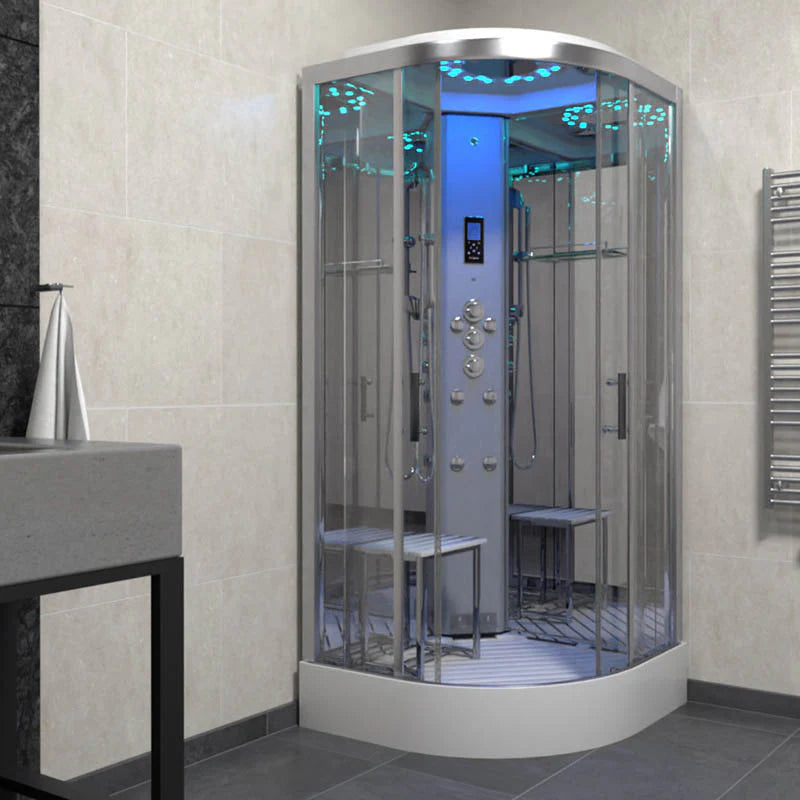Sweating over whether a Steam Room or Sauna is better? You're not alone. From dry heat to steamy bliss, the choice between a Steam Bath and sauna depends on what your body craves. Short answer: both are great — but for different reasons. Keep reading to find your perfect sweat match!

Understanding the Basics: Sauna vs. Steam Room
Dry Heat vs. Moist Heat
Saunas deliver dry heat. Temperatures typically range from 65–90°C (150–195°F), with very low humidity — around 5–30%. This creates a warm, breathable environment that doesn’t feel overly intense.
Steam Rooms offer moist heat at a gentler 43–49°C (110–120°F), but with nearly 100% humidity. The vapour makes the heat feel more enveloping and heavier.
How Each Works on Your Body
In a sauna, your body produces sweat, and the dry air allows it to evaporate. This helps regulate your body temperature and creates a steady warming sensation.
In a steam room, the air is already saturated with moisture. So sweat doesn’t evaporate easily, leading to a more intense sensation of heat even at lower temperatures.
Exploring the Benefits: Sauna vs. Steam Room
Health Benefits of Saunas
-
Cardiovascular Health
Saunas gently raise your heart rate. This promotes blood circulation and may help reduce blood pressure over time. -
Muscle Relaxation and Pain Relief
The heat relaxes tense muscles and joints. It’s great after exercise to ease soreness and stiffness. -
Stress Reduction and Improved Sleep
Regular sessions can lower cortisol levels. This helps you unwind and may lead to better sleep quality. -
Skin Cleansing and Detoxification
Sweating in a sauna encourages the release of toxins and dirt through the skin. -
Potential Immune Support
Some studies link sauna use with reduced risk of colds and improved immune response. -
Cognitive Health Potential
There is growing research suggesting that sauna therapy may support brain health. Though more evidence is still needed.
Health Benefits of Steam Rooms
-
Respiratory Health
Steam helps loosen mucus and open airways. It’s especially helpful for asthma, colds, or sinus pressure. -
Skin Hydration and Cleansing
The humidity hydrates the skin while opening pores. This can leave your face feeling smooth and moisturised. -
Muscle Recovery and DOMS Relief
Steam is excellent for soothing deeper aches. Moist heat can penetrate muscles more thoroughly than dry heat. -
Stress Reduction and Relaxation
The warm, misty air is deeply calming. It can ease tension and support mental well-being. -
Improved Circulation
Steam boosts blood flow, especially to the legs and feet. This may help reduce swelling or heaviness. -
Joint Flexibility and Pain Relief
Steam therapy can loosen stiff joints. It may also provide comfort for those with arthritis or joint pain.
Choosing Your Ideal Experience: Which is Better for You?

Consider Your Preferences
Do you prefer dry or humid heat? That’s often the deciding factor.
Think about your wellness goals too. Is it skin care, muscle recovery, stress relief, or breathing support?
Also consider how much heat you can tolerate. Saunas tend to feel hotter, while steam can feel more intense due to humidity.
Specific Considerations
-
Respiratory Issues: Steam rooms are generally better due to moist heat supporting airways.
-
Muscle Recovery: Both work well. Moist heat helps deep muscle soreness, while saunas improve circulation.
-
Detoxification: Sweating occurs in both environments. Both are effective in this area.
-
Skin Health: Steam hydrates and opens pores. Saunas cleanse via dry heat and heavy sweating.
Trying Both Before Deciding
If possible, try both at a gym or spa. Compare how your body reacts.
Some people love the invigorating feel of a dry sauna. Others prefer the humid hug of a steam bath.
Let your body guide you.
Important Safety Considerations and Tips
-
Hydration is Key
Drink water before, during, and after sessions. Dehydration can sneak up quickly in either environment. -
Recommended Session Duration
Aim for 10–20 minutes. If you feel light-headed or unwell, step out immediately. -
Who Should Avoid It
People with heart disease, kidney issues, liver problems, or those who are pregnant should consult a doctor first. -
Speak to a GP
When in doubt, get medical advice. This is especially important if you have chronic conditions.
Conclusion: Enjoying the Benefits of Both
When comparing the sauna vs steam room, there’s no single “winner.” It comes down to your needs, preferences, and how your body responds.
Saunas are ideal for boosting circulation, relaxing muscles, and promoting mental clarity.
Steam baths are perfect for respiratory comfort, softening skin, and delivering that humid warmth.
You don’t have to choose just one. Alternate between both — or pick whichever suits your day. Just stay hydrated, know your limits, and enjoy the ride.
Takeaways
-
Saunas = dry heat, great for heart health, stress relief, and circulation
-
Steam Rooms = moist heat, ideal for breathing, hydration, and deeper muscle relief
-
Both offer detox, relaxation, and recovery benefits
-
Stay hydrated and follow safe session lengths
-
Listen to your body — and enjoy the sweat!






